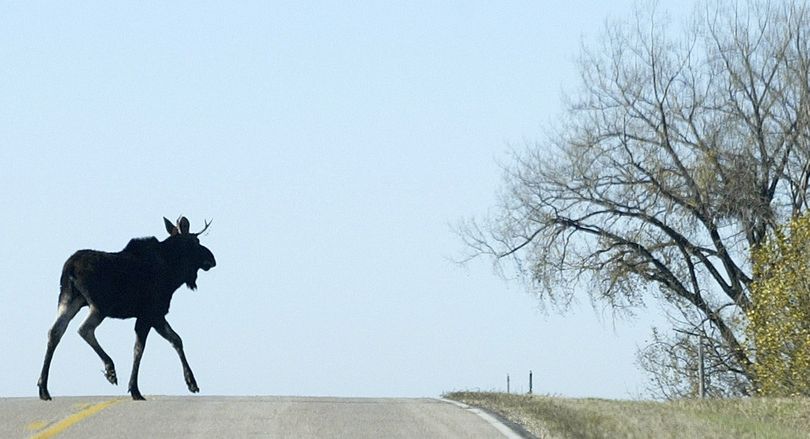Study: Wolf impact significant on Minnesota moose

BIG GAME -- Wolves likely have played a bigger role in the serious decline of northeast Minnesota’s moose population than originally believed, and there’s no evidence yet that climate change has been a major factor, according to a new analysis by renowned Minnesota wolf researcher Dave Mech.
The story was reported last week by Doug Smith of the (Minneapolis) Star Tribune.
Mech doesn’t dismiss climate change as a possible factor in the declining moose herd, but said evidence presented in earlier research done by the Department of Natural Resources "just doesn’t hold up."
Instead, an increasing wolf population in at least part of the northeast moose range might have contributed to the decline, Mech and John Fieberg, an assistant professor at the University of Minnesota, concluded in a recently published paper. The state’s northeast moose herd has fallen 50 percent since 2006, to an estimated 4,350 animals last winter.
In the earlier studies, DNR researchers considered the statewide wolf population stable between 2000 and 2010, which was correct, Mech said. But they didn’t consider that the wolf population in an area that Mech has been studying - which overlaps part of a moose study area - had increased to the highest levels in 40 years.
"My data tends to indicate the problem was there were more wolves," Mech said in an interview. "But that doesn’t necessarily mean that’s the only answer. Is there some change affecting moose that allows wolves to take more of them, or is it merely that there’s more wolves?"
If wolves are a major factor in the moose decline, Mech said the DNR could allow hunters to kill more wolves in the moose range until the population recovers.
Michelle Carstensen, DNR wildlife health program supervisor, who in 2013 began conducting an adult moose mortality study using radio-collared animals, said the previous DNR studies looked at overall mortality, but researchers weren’t able to determine cause of death in most cases.
"We assumed wolves were accounting for a portion of that mortality, but we didn’t know how much," she said.
But now officials are finding how much impact wolves are having on moose mortality. The study radio collars alert researchers when an animal has died, and provide GPS coordinates so they can be quickly located and a cause of death determined.
So far in the study, the overall mortality rate is 26 percent, which is a concern. Normal stable moose populations have an 8 to 12 percent mortality rate. Wolves have accounted for 55 percent of the mortality (17 of 31 deaths); the rest died from health issues.
"The level of wolf predation on the adults is well in line with what we’d expect," Carstensen said. "It’s the overall mortality 61/87from all causes63/87 that has us concerned."
She noted that the northwest moose herd plummeted from about 4,000 in the ’80s to fewer than 100 today, and wolves had nothing to do with that. Those moose died from health-related issues, possibly driven by climate changes.
And, she said, adult moose in the northeast keep dying in summer, fall and early winter "when they shouldn’t be dying."
Carstensen said the results from current ongoing moose studies, which also include moose calves, habitat and diet, should eventually provide researchers with answers to the mystery. "There still might not be a smoking gun; it might be very complex," she said.
So far, in a different study involving collared moose calves, 67 percent of the mortality was due to wolves.
"Wolf predation is probably a little higher than we expected," DNR researcher Glenn DelGiudice said. "But we knew it would be a main source," he said, and it’s far too early to draw any conclusions.
He is planning on collaring more moose calves next spring, and said several years of data are needed.
Mech’s latest report says the northeast moose population was relatively unaffected by wolves from 1997 to about 2003 and that wolf numbers tended to parallel moose numbers. However, after the wolf population in his study area jumped 81 percent between 2000 and 2006 - from 44 animals to 81 - moose numbers began declining.
"We don’t know how far and wide that increase 61/87in the wolf population63/87 took place, but it did in our study area, and that area was adjacent to the moose study area," Mech said. He said it’s reasonable to surmise the wolf population in the rest of the moose study area also was rising, rather than remaining stable, as it was elsewhere.
Moose are a prime food source for wolves in the northeast, so as the moose population declines, one would expect the wolf population to eventually fall, too. "That seems to be happening in our study area," Mech said. The wolf population there increased until 2012, but he said it appears to have since declined.
The DNR estimated the state’s wolf population last winter at 2,423, stable from 2013.
So if the wolf population in moose country is declining, will moose rebound?
"That depends on what’s going on," Mech said. "If it’s strictly wolves, the moose population will recover. But if there are other factors involved - parasites, disease or warming temperatures, then it’s hard to say."
And if wolves turn out to be a major factor, then the DNR will have to decide whether to try to lower the population of one iconic animal to try to boost the population of another.
